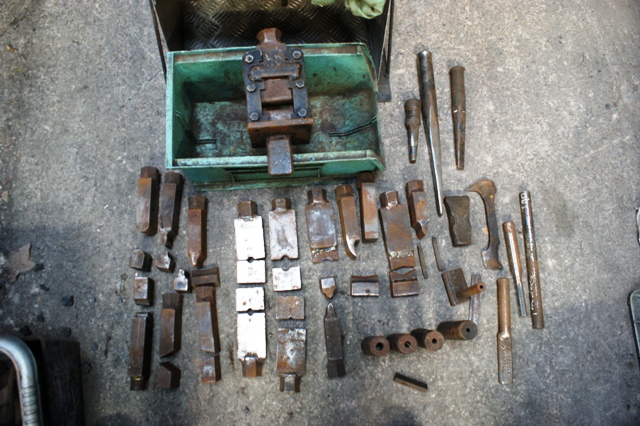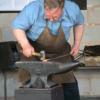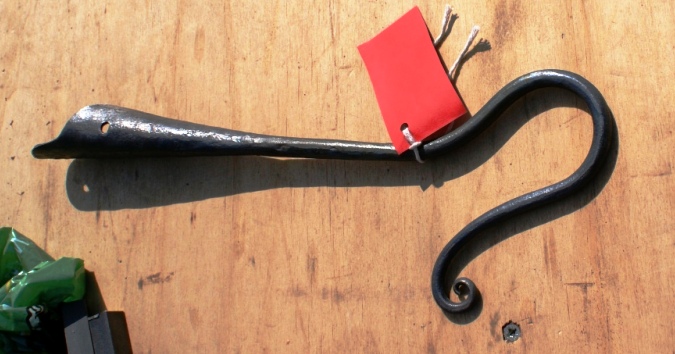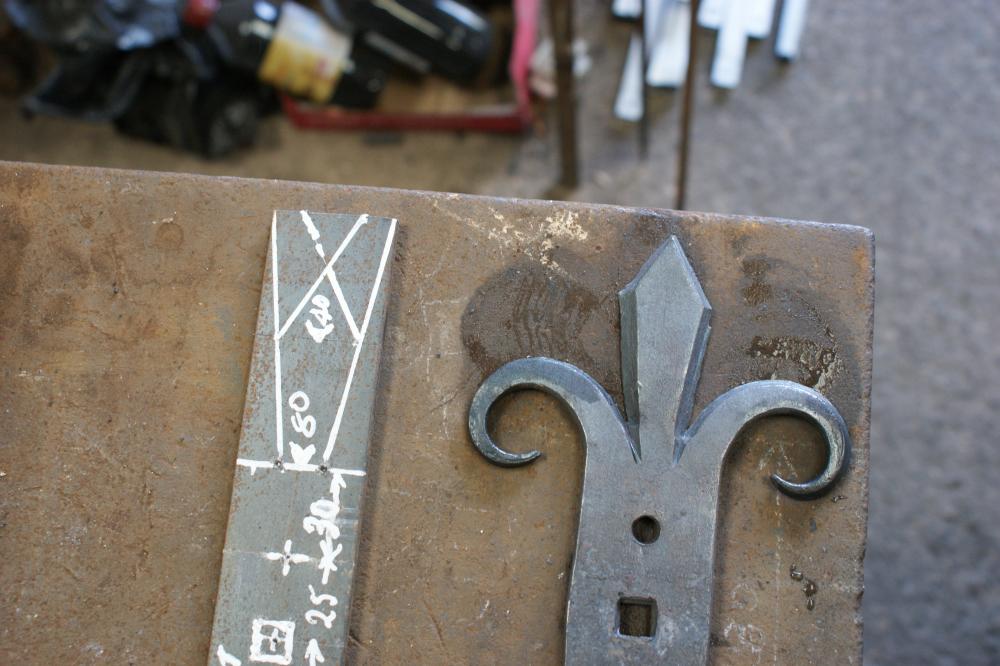-
Posts
3,598 -
Joined
-
Last visited
Content Type
Profiles
Forums
Articles
Gallery
Downloads
Events
Posts posted by John B
-
-
Did the seller explain how he used to use the hammer and what to expect from it.? And I would also ask about the C pieces, they could be for all sorts of things related to how the machine is used or maybe even they don't belong with the machine
There are others who are a lot more familiar with this make of hammer and no doubt will respond favourably to your queries.
Based on that just a couple of statements from myself . The dies are angled so you can pass long workpieces between them, place them square on and you are limited by the throat depth to the lengths you can draw out.
The ram may withdraw to the highest position when the machine is started, the tup usually is supported by a wooden block or similar when not in use, when the machine is switched off, gravity takes over and the tup will descend onto the bottom die.
Speculating, the silver handle may move more for selection when the machine is working, I understand they need to be warmed up and well run in to get optimum performance.
I hope others can be more informative on the matter for you,
Have fun and enjoy, and remember to use on metal that is really hot to be effective.
-
17 hours ago, RyanMark said:
I'd like to polish it to a mirror finish before I start working it. For me, this would make more sense than polishing/buffing afterwards.
Forgive me, but I don't see or experience the logic in this train of thought,
Any working is going to produce scarring of some sort and degree, the careful use of handling and forming techniques along with highly polished forming tools will help keep surface damage to a minimum so less finish polishing of the material is required, and if you are annealing the copper before forming, then the highly pre polished surface will suffer in the process.
Buffing is my preferred way of achieving different degrees of a polished surface, depending on the compound used.
-
4 hours ago, blackleafforge said:
Thanks for the info all. If you want to swing by you can have a sheet John.
Thanks for that, I appreciate the offer, and maybe drop down to see you sometime when I am not so busy doing nothing.
-
As KRS states it was a form of flux, a propriatory brand that was popular up until the late fifties early sixties,(when wrought iron was still available) especially useful when putting working faces on to tools eg hammer faces, lathe, milling and other tools. It could be cut to shape to suit the application,
It was the "magic compound" of the day for forge welding steel to wrought iron, it would be interesting to see a chemical analysis of what you have there.
I've often heard it mentioned by the old time mentors, (with some cheaper alternatives also) but that is the first time I have seen that particular package.
Does it mention country of origin?
A great little nugget of the smithing history, I wonder how many more examples survive.?
Great find,
-
4 hours ago, Prevenge said:
Do yourself a favor and do not come up here....almost all of us are terrible people. Just terrible. Sarcasm aside......Listen to the words of your most prominent village idiot Donald Trump if you are thinking of sneaking in illegally. According to him you get 8 years of hard labor if you get caught sneaking in to Canada .
8 years ! That seems a good deal, most 'smiths end up once they have started, with a life sentence of hard labour from then on.
-
Thanks for posting this Alan, she was a very gracious lady and it was an honour to have met her on several occasions.
Hopefully the executors will get the book published and then there will be something else for future generations to be appreciative for, and reward and reinforce marking her endeavours and contribution to, and on behalf of, the ironworking community.
-
Ideal low cost blowers, and relatively quiet. you will need an air gate, and an adaptor plate to bring exhaust port down to your required diameterto fit to tuyere.
Only downside is they are usually a plastic housing, so need to be sited away from heat or hot debris.
-
48 minutes ago, Forging Carver said:
John those are so cool! How do you make those? I have read something a long while ago, I gotta find it again. Thanks
David Hammer is the guy I credit with this item, he has a good video on the sheep channel (ewe (you) tube) for all to follow, made in 2010, and this basic method can be easily adapted to produce various styles.
I punch the hole for the split ring, but these can be drilled after they are finished, the punching is probably the most difficult part as it tends to flatten the area around it which can distort the finished shape, do it when the brim is flat, and the hole distorts when you shape the brim.
Have fun trying them.
-
A small group of members attended the Lambing Day event held at Bicton College to help promote our new start at Westpoint, It was very cold, but a lot of visitors stopped to view what we were doing.
Here are some pics
I also made these, and have put more pictures on a Show us your Key rings thread in theDiscussion section.
And here are a couple of pics from the Ypres poppy making day.
Next Members day will be April 9th at Westpoint,
-
I thought this thread already existed, but could not find it even after an extensive search. Because of their popularity and learning content, I thought it may be a good idea to start one.
It is not often I get the opportunity to have some forge time these days, but yesterday the BMASW were at a public event demonstrating, and I made this selection from discs 2" diameter x 1/16" (16swg)
Quick to do and popular with visitors,
Enjoy and lets see your key rings.
-
I assume this is a cutting disc machine you are using as opposed to a cut off saw
You may be using too much pressure on the workpiece, let the tool do the work, or as Dwarf mentions the edge will get shiny, this is due to excess friction and overloading the wheels matrix causing the "bluntness" which rubs not cuts, be patient, maybe ease off a little and if it is a hand held machine, try a little sawing type motion.
A similar phenomon also occurs in static mounted machines when discs are worn, and optimum cutting angles with disc's periphery become distorted on approach and during cutting.
I have come across inclusions too in recycled metals, the worst example seemed to be a carbide tip in an otherwise piece of mild steel.
-
Here are some pics of my old "Travelling workshop tooling" on a wheeled trolly, covers most tools I used and found useful
.jpg.b4965f823b2b4c761f720a38a9eff429.jpg)
.jpg.38925570e44ea663b296391e7ad42f43.jpg)
.jpg.054d0c5c8a878546e158b590f91ac00e.jpg)

-
-
-
Technique and practice your hammer control,
Material should be hot, not warm, HOT !!!!
Let the hammer do the work and use appropriate places on your anvil as a fuller.
Hit it like you mean it, take a video of yourself and then look at it to see how you are performing and what works best for you, then you can improve.
Look at other 'smiths techniques and what they use hammer wise and develop what works best for you.
Or you could just weld on round stock to your forged jaws business end.
-
Hi Andy, Ffoss-y-fran coal from an open cast mine is available and stocked in Devon, (This is a Welsh mine, not Scottish but has the same properties you describe))
The BMASW at Westpoint Forge will be using this when existing coke stocks are used up, come along to a members day held each second Saturday in the month to see it in use or try it for yourself.
-
You are welcome, suffer from the same problem myself, the older I get the more I forget, the bonus is, there is lots more to learn !
-
On 2/20/2016 at 1:31 AM, John McPherson said:
I give up! Rejects all cut & paste attempts.
http://www.tharwavalleyforge.com/articles/reference/51-journeyman-blacksmithing-skill-standards
-
-
Saturday February 13th, at Westpoint Forge we will be holding the general meeting to decide what the members want now that the Guild of Wrought Ironwork Craftsmen of Wessex have taken their courses and operations elesewhere.
This is an opportunity to start afresh and to make it what our members want it to be. If you would like to be a part of this, then come along and join in or just see what we have to offer.
Currently there are plans for a regular Three day Intensive Basic Blacksmith Skills courses, these items are the ones made at Westpoint, based on the skills needed to produce traditional projects. More skills can be learnt on the Members days and other specific courses members may request .
We also have scheduled in for the year a Monthly Members Day, held every second Saturday each month.
To participate or contribute, why not come along and have your say, or just be curious and find out a little more.
To launch the new set up. we exhbited at a local craft show and received quite a lot of interest, here are some pictures from the show of items made at Westpoint.
If you can help or want to learn or use the facilities, come along and enjoy the day.
-
Also used to drill between joists or ribs and other confined spaces.
-
I think it would be safe to assume the 4-5mm (3/16") would be the diameter of the bolt or material they were made for.
You would require one the size of the shank of the spike you are going to be using,
-
Could make it at a mutually convenient time if you have the bits, or phone or email me and we can sort something out.
-
9 hours ago, blackleafforge said:
Thanks for the replies. I would possibly have gone with a length of RSJ or similar attached to a wheel hub but I don't have any welding equipment at the moment. Railway sleepers seem like a good idea i could stack a few together and brace them with a metal band and put some bits of wood at right angles on the base for stability. I will go and check availability. thanks
If you need any welding doing, we can arrange to do it at Westpoint on a members day or some other time, contact me if you want to take the opportunity.



.thumb.jpg.2ad8787825f90ccc6e64990e697cf14e.jpg)

.thumb.jpg.acce392b6657abb01f5200e1db3aa584.jpg)
.thumb.jpg.046fb978f78f36d45d9bcdf283ee2c91.jpg)
South west coal distribution
in Blacksmiths and Metalworkers Association of the South West UK
Posted
Hi Anthony, you can purchase coke off the internet and have it delivered.
I believe you will find Symonds are now out of coke, but do have coal, we have just taken delivery of half a tonne, and it is cheaper than the coke, and seems to work well, once it is in use, we are still getting into how best to use it.
The main reason we are going over to coal is because the forging coke used (from Monkton) is no longer being processed. It was mainly supplied and used for the power stations which are being converted or shut down,
Your assumption "that coke was an easier fuel to use" is also questionable, Originally in the UK, charcoal came first, then came coal used in the Industrial revolution and steelmaking processes, and also by blacksmiths, the preferred coals being from the South Yorkshire and South Wales pits, then along came the "smoke free zones" and pollution control areas, and the shutting down of the collieries in the 1970's, so the supplies of suitable forging coal became minimal or unobtainable being replaced by the coke which was a by product of the Chemical industry and later supplied to power stations, now suffering again from the Non pollution policy.
Coke has different properties to coal, it burns hotter which can cause problems with dry tuyeres burning them out pretty rapidly, it is a pain to start, and needs a constant airflow or it goes out pretty quickly, Use too much air and your workpiece suffers, and you need to leave the blower on and then you are using more fuel than you need to. It also produces more clinker than the coal.
With coal it lights easily, Initially it will smoke, but once you have your first forging session over with then using the part coked coal to light your next fire, little or no smoke is seen, work new fuel in from the edges and not directly onto the hot spot,
You can control the size of the fire using air flow, or water dampening.
You can leave the fire with no air and come back and still be able to easily restart it,
One problem to be aware of with coal is you want to make sure the fire is doused at the end of the forging session or if you have an excess of new coal around the fire area, the fire will spread and consume this fuel, and could be still alight in the morning when you come back to work (Don't ask how I am aware of this)
Ayy fuel can be used to get your metal hot, a lot is based on what you were introduced to as a beginner, and what was available at the time.
The coal we now use is from South Wales http://www.oldglory.co.uk/news/-ffos-y-fran-premium-welsh-dry-steam-coal and available throughout the UK, and it has always been our policy on the courses to use materials and fuels that is available to the students and the area they live in.
There are three grades/sizes most smiths seem to prefer the smaller(sold as a domestic use fuel as Gloda)nuts or large nuts but not the cobbles.
If you want to try some then feel free to pop along to one of our member's days, every second Saturday in the month, www.blacksmiths-training.org.uk or you could try googling Cornish Blacksmiths Association, or Dingles Steam Village and asking them where they get their fuel from